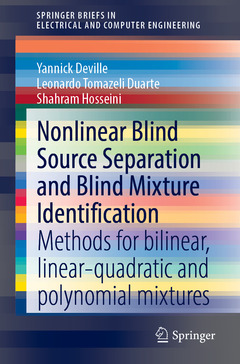Nonlinear Blind Source Separation and Blind Mixture Identification, 1st ed. 2021 Methods for Bilinear, Linear-quadratic and Polynomial Mixtures SpringerBriefs in Electrical and Computer Engineering Series
Auteurs : Deville Yannick, Duarte Leonardo Tomazeli, Hosseini Shahram

Introduction.- Expressions and variants of the linear-quadratic mixing model.- Invertibility of mixing model, separating structures.- Independent component analysis and Bayesian separation methods.- Matrix factorization methods.- Sparse component analysis methods.- Extensions and conclusion.- Bilinear Sparse Component Analysis methods based on single source zones.- Conclusion.
Yannick Deville was born in Lyon, France, in 1964. He graduated from the Ecole Nationale Supérieure des Télécommunications de Bretagne (Brest, France) in 1986. He received the D.E.A and Ph.D. degrees, both in Microelectronics, from the University of Grenoble (France), in 1986 and 1989 respectively. From 1986 to 1997, he was a Research Scientist at Philips Research Labs (Limeil, France). His investigations during that period concerned various fields, including GaAs integrated microwave RC active filters, VLSI cache memory architectures and replacement algorithms, neural network algorithms and applications, and nonlinear systems. Since 1997, he has been a Full Professor (now a so-called “Exceptional Class Professor”) at the University of Toulouse (France). From 1997 to 2004, he was with the Acoustics lab of that University. Since 2004, he has been with the Astrophysics lab in Toulouse, which is part of the University and of the French National Center for Scientific Research (CNRS). Asfrom 1994, he has been the coordinator of his successive research groups. In addition, since 2011, he has been leading the “Signal, Image in Universe Sciences” research team of his lab. His current major research interests include signal and image processing (especially hyperspectral data), higher-order statistics, time-frequency analysis, neural networks, quantum entanglement phenomena, and especially Blind Source Separation and Blind Identification methods (including Independent or Sparse Component Analysis and Nonnegative Matrix Factorization) and their applications to Remote Sensing, Astrophysics and Quantum Information Processing. Yannick Deville has more than 300 publications (see details at http://userpages.irap.omp.eu/~ydeville/publi.html ), including a single-author book and 12 book chapters (one in Wiley Encyclopedia of Electrical and Electronics Engineering). He owns 25 patents and Soleau envelopes. He participated in several international research projects (e. g. SPECPDR f
Date de parution : 02-2021
Ouvrage de 71 p.
15.5x23.5 cm



